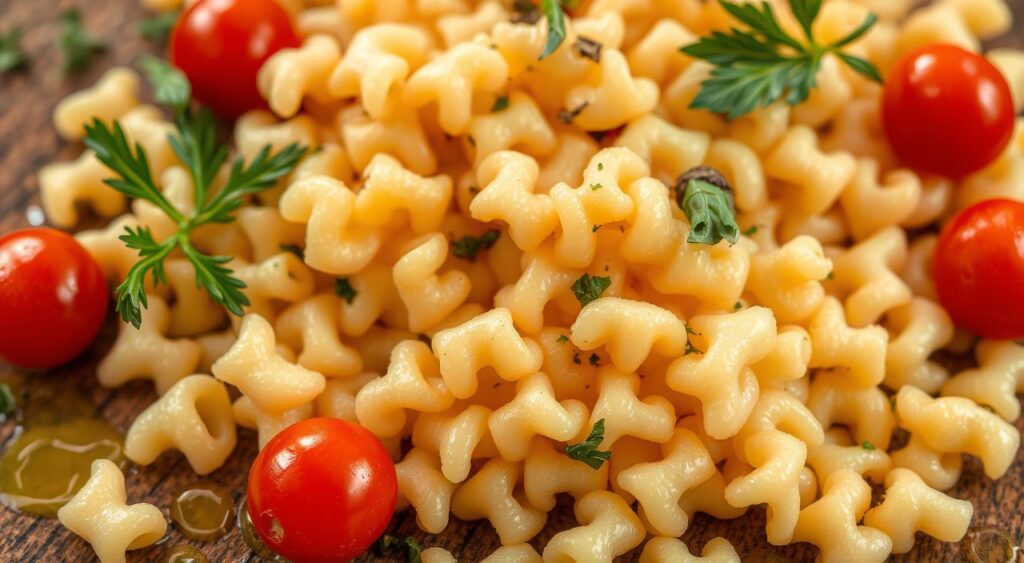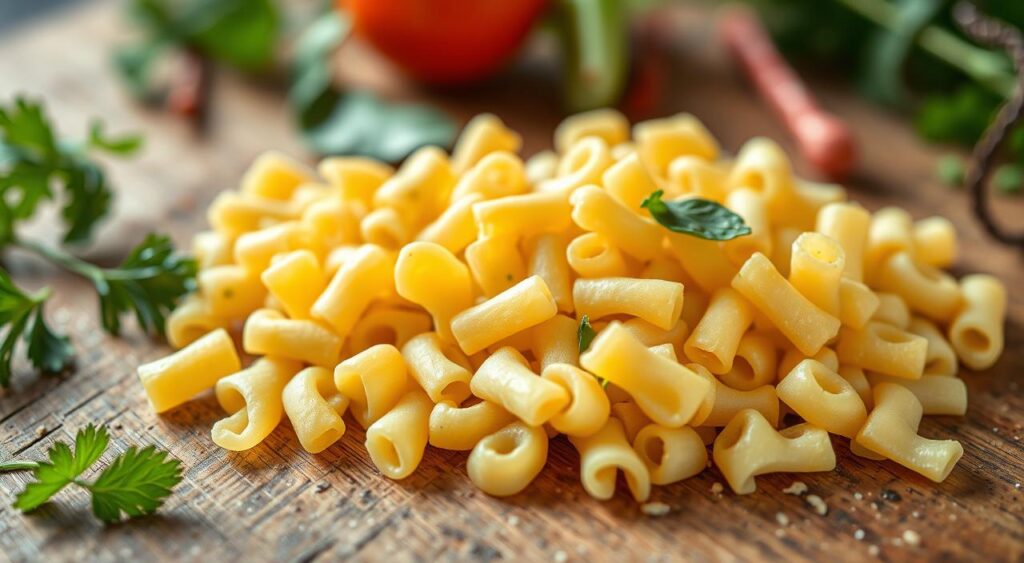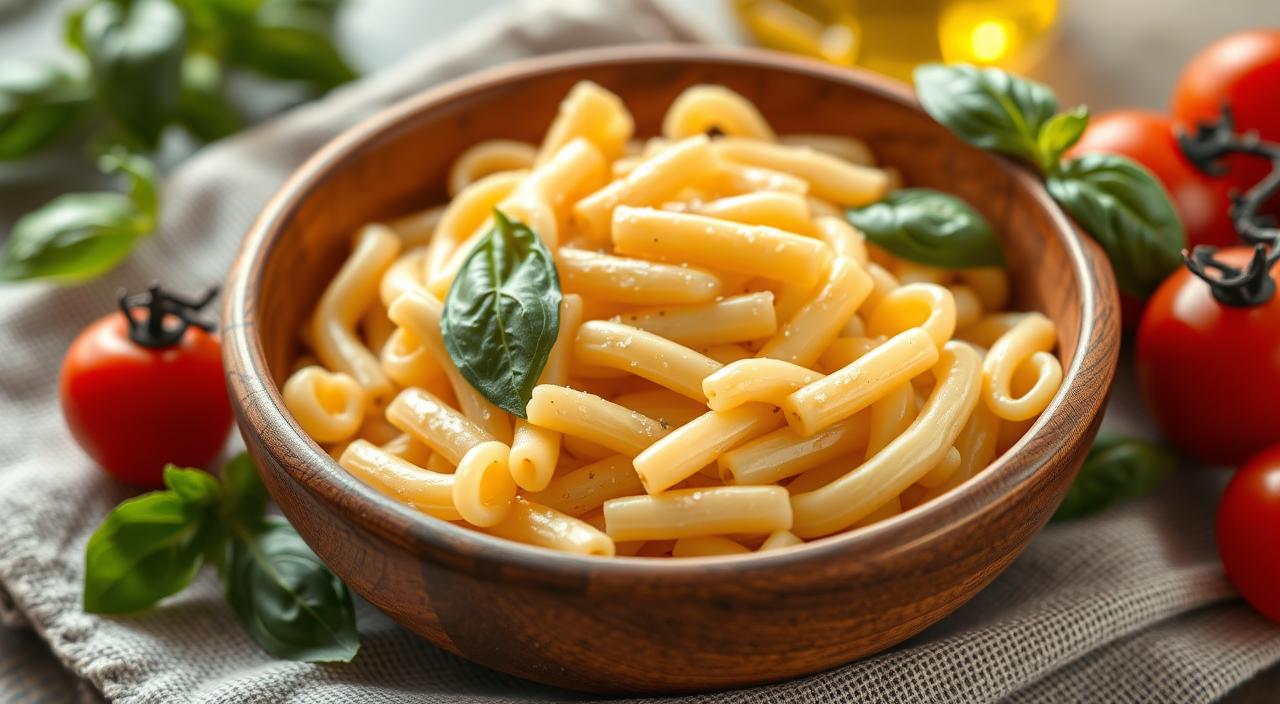As you walk through your local Italian market, you might notice the small, ridged tubes called ditalini. These “little thimbles” have a long history and a rich taste. They are a favorite in traditional Italian cooking. Let’s dive into the world of ditalini pasta and see why it’s a must-have in your kitchen.
Ditalini pasta is a tiny tube shape from Italy’s southern regions, like Campania and Puglia. Its unique ridges and small size make it perfect for soups and stews. It’s great at holding onto sauces and small ingredients. But ditalini is also versatile for pasta salads, baked dishes, and more.
Understanding Ditalini Pasta: Origins and History

Ditalini pasta comes from the Puglia region in Italy. Its name, “ditalini,” means “little thimbles” in Italian. This small, tube-shaped pasta became popular in the 19th and 20th centuries with the rise of industrial pasta making.
Etymology and Historical Significance
The name “ditalini” matches its small, thimble-like shape. It was also called “Garibaldini” in the past, named after Giuseppe Garibaldi. But, “ditalini” is the name that stuck.
Evolution Through Italian Cuisine
Ditalini pasta is a big deal in Southern Italian cooking, especially in Sicily and Calabria. It’s used in soups and pasta dishes, showing its versatility. Over time, it has become a key part of Italy’s food history.
Traditional Uses in Southern Italy
In Southern Italy, ditalini pasta is loved for its role in many dishes. It adds texture to soups like minestrone and pasta e fagioli. It’s also in pasta bakes and casseroles, making it a favorite in the region’s kitchens.
What Makes Ditalini Pasta Special

Ditalini pasta is special because of its small, hollow shape. This shape lets it hold onto broths, sauces, and small ingredients well. It’s great for soups, pasta salads, and baked dishes.
It’s also known as “salad macaroni” because it’s popular in cold pasta salads. The small size of ditalini pasta is perfect for soups and similar dishes. It adds a satisfying texture and flavor to every bite.
Ditalini pasta is not just about its shape and size. It’s made from high-quality durum wheat and uses a special method to make it. This results in pasta that sticks well to sauces and stays al dente after cooking. It’s a great base for many flavors, from tomato-based sauces to creamy pesto or cheese.
“Ditalini pasta is a true culinary gem, offering a unique and delightful eating experience in a wide range of dishes. Its small size and hollow tube shape make it a standout choice for soups, salads, and baked pasta creations.”
The Art of Making Traditional Ditalini Pasta
Ditalini, a beloved Italian pasta variety, is made with great care. It comes from the Puglia region near Naples, at the start of the Amalfi Coast. The making starts with the best durum wheat, known for its high gluten and protein.
Quality Ingredients
The durum wheat is ground into coarse semolina flour. It’s mixed with fresh mountain spring water. This mix keeps the pasta’s texture and Italian taste true.
Bronze Die Extrusion Method
The dough is pushed through bronze dies, a traditional way. This gives the petite pasta a rough, porous surface. This texture helps hold onto sauce flavors. The pasta is dried slowly to keep its color, smell, and quality.
Making traditional ditalini pasta shows Italy’s rich culinary history. Producers like DeLallo use old methods and top ingredients. This keeps ditalini a favorite in kitchens everywhere.
Cooking Techniques for Perfect Ditalini
Ditalini, those tiny pasta tubes, can be cooked in two main ways. You can boil them in water or cook them in a soup. The secret to perfect small pasta shape is to follow a few easy steps.
To cook ditalini in boiling water, start by boiling a large pot of salted water. Then, add the pasta and cook for 8-9 minutes. Stir the pasta often to prevent sticking and ensure even cooking.
For cooking ditalini in a soup, add them towards the end. This lets the pasta soak up the broth’s flavors. Stir the pasta now and then to keep it from clumping and to keep its shape.
“The key to perfect ditalini is to cook it just until it’s al dente, whether in boiling water or directly in a soup. This preserves the pasta’s texture and allows it to soak up all the delicious flavors around it.”
By following these simple steps, your ditalini pasta dishes will always be perfect. This lets you enjoy the unique taste of this small pasta shape.
Popular Dishes Featuring Ditalini Pasta
Ditalini pasta is a versatile ingredient that shines in many dishes. It’s great in soup pasta and pasta salad creations. This pasta adds a delightful texture and taste to your meals.
Classic Soup Applications
Ditalini pasta is a staple in Italian soups like Minestrone and Pasta e Fagioli. Its small size fits perfectly with vegetables and beans. This makes every spoonful a delightful experience.
The pasta stays firm even in soups. This makes it an excellent choice for these comforting dishes.
Pasta Salad Variations
In pasta salad recipes, ditalini pasta pairs well with crisp vegetables and fresh herbs. The small shape ensures a perfect mix of flavors and textures. It’s a favorite for picnics, potlucks, and summer gatherings.
Hot Pasta Dishes
Ditalini pasta is also great in hot pasta dishes. It’s perfect for creamy sauces in baked pasta casseroles. Or, it can be mixed with small vegetables like peas for a simple meal.
It’s also a great substitute for macaroni in classic mac and cheese. This adds a unique twist to a beloved comfort food.
“Ditalini pasta is a true chameleon in the kitchen, adapting seamlessly to a wide range of dishes and culinary styles.”
Nutritional Benefits and Dietary Considerations
Ditalini, an Italian pasta variety, is packed with nutritional benefits. It’s mainly made of carbohydrates, giving you energy. It also has more protein than other wheat pasta, making you feel fuller.
For those with dietary restrictions, ditalini is a good choice. You can find whole wheat or gluten-free options. It’s also made in facilities that avoid peanuts, tree nuts, and eggs, helping those with allergies.
Ditalini pasta, like most pasta varieties, is primarily a source of carbohydrates. It provides energy and can be part of a balanced diet when consumed in moderation.
Ditalini’s small size and shape make it great for many dishes. It’s perfect for soups and pasta salads. Its shape helps it soak up flavors, making meals more delicious.
Looking for a nutritious Italian pasta or a small pasta shape? Ditalini is a great choice. It’s versatile, fits various diets, and is nutritious, making it a great addition to meals.
Comparing Ditalini with Other Small Pasta Shapes
Choosing the right pasta can make a big difference in your cooking. Ditalini, a small tubular pasta, is unique among its peers. It’s part of the “ditale” family, known for its tiny size.
Size and Shape Differences
Ditalini, meaning “little thimbles” in Italian, is the smallest in the ditale family. It’s smaller than ditaloni and ditali, and unlike orzo, it’s tubular. It’s a bit smaller than tubetti pasta, making it perfect for soups and salads.
Best Usage Scenarios
Ditalini’s small size is great for soups and pasta salads. Its shape fits well in broths and dressings. It’s also balanced in every bite. Larger pasta shapes like ditaloni are better for creamier soups or thick sauces.
Choosing between smooth or ridged ditalini depends on the sauce’s thickness and your taste. Whether you pick ditalini or try other small pasta shapes, knowing their differences helps you make delicious dishes.
Best Sauces and Pairings for Ditalini
Ditalini’s small, hollow shape makes it great for many sauces. Smooth sauces coat it evenly, bringing out balanced flavors. Pesto, a classic Italian sauce, is a favorite for this salad pasta. Creamy and cheesy sauces also pair well, adding richness and indulgence.
For a classic taste, try simple tomato sauces or olive oil-based ones. Light garlic sauces also complement ditalini’s delicate texture. In soups, ditalini works well with both clear broths and creamy bases. It adds a comforting texture and bite.
When it comes to pasta salads, light vinaigrettes or mayonnaise-based dressings are perfect. They let ditalini’s shape and texture stand out.
“The variations of pasta and sauce combinations are limitless, promoting creativity and personal preferences in pairing choices.”
Ditalini’s versatility makes it a childhood favorite pasta for many dishes. It’s perfect for both classic Italian meals and modern twists. Whether you want a comforting soup or a vibrant pasta salad, ditalini is the ideal choice.
Storage Tips and Shelf Life
Storing your ditalini pasta right is crucial for keeping it fresh. This small, tube-shaped pasta can last a long time if stored properly. To keep it fresh, store it in an airtight container in a cool, dry place. This way, unopened ditalini pasta can stay good for 1-2 years after the printed date.
After cooking, store ditalini pasta in a sealed container in the fridge. It’s best to eat it within 3-5 days. Freezing cooked ditalini pasta isn’t recommended because it can change the texture and quality when thawed. But, if you must freeze it, do so for up to 2 months in a sealed container or bag.
“Proper storage is essential for maintaining the freshness and texture of ditalini pasta, whether it’s dried or cooked.”
Always check the package for storage tips and eat your ditalini pasta within the suggested time. By following these easy storage tips, you can enjoy this Italian pasta variety for months.
Regional Variations and Cultural Significance
Ditalini pasta is a beloved part of Southern Italy’s food traditions. It’s especially popular in Sicily and Calabria. In these places, it’s known as “little thimbles” and is often used in soups and pasta dishes.
In Sicily, ditalini is a key ingredient in pasta chi vruocculi arriminati. This dish combines ditalini with cauliflower, making it a favorite among locals.
Italian Regional Preferences
Ditalini’s roots are in Southern Italy, but its appeal has spread across the country. Each region in Italy has its own pasta shapes and varieties. These reflect the unique culinary traditions that have developed over time.
International Adaptations
Ditalini has also become popular worldwide. In the United States, it’s a staple in pasta salads and comforting soups. Its small size and versatility have made it a favorite in many American homes.
It often brings back memories of childhood favorites. This makes ditalini a special part of many people’s culinary experiences.
“Ditalini pasta is a true representation of the rich culinary heritage and regional diversity that makes Italian cuisine so captivating. From its roots in Southern Italy to its international adaptations, this little pasta variety continues to delight palates around the world.”
Ditalini’s lasting popularity shows the power of traditional food in shaping culture. It connects people within and outside Italy. As more people around the world enjoy Italian food, ditalini’s importance will only grow.
Common Substitutes for Ditalini Pasta
If you can’t find ditalini pasta, don’t worry. There are many other pasta shapes you can use instead. Tubetti or tubettini, for example, are very similar in size and shape. They’re great for recipes that need ditalini.
For soups, orzo or acini di pepe are good choices. They have a similar texture and can soak up flavors well. In pasta salads, elbow macaroni works too, but it might look and feel different than ditalini.
For warm pasta dishes, small shells or elbows can be good substitutes. Just remember to adjust the cooking time because of the shape and size differences. Always follow the package instructions to cook the pasta just right.
FAQ
What is ditalini pasta?
Ditalini pasta is a small, tube-shaped pasta with ridges. It’s called “little thimbles” in Italian. It belongs to the pastina family, which includes many tiny pasta shapes.
Where does ditalini pasta originate from?
Ditalini pasta comes from the Puglia region of Italy. The name “ditalini” means “little thimbles” in Italian. This reflects its small, tubular shape.
What makes ditalini pasta unique?
Its small, hollow shape lets it hold broths, sauces, and small ingredients well. This makes it great for soups, pasta salads, and baked dishes.
How is traditional ditalini pasta made?
Traditional ditalini pasta is made from high-quality durum wheat. The wheat is milled into coarse semolina flour. Then, it’s kneaded with cold, fresh mountain spring water and extruded through bronze dies.
How do you cook ditalini pasta?
You can cook ditalini pasta in boiling water or directly in soup. To cook in water, boil a large pot of salted water. Add the pasta and cook for 8-9 minutes or until al dente. For soups, add the pasta towards the end to prevent overcooking.
What dishes can ditalini pasta be used in?
Ditalini is great in many dishes. It’s perfect for soups like Minestrone and Pasta e Fagioli. It’s also good in pasta salads, creamy baked pastas, and even as a mac and cheese substitute.
Is ditalini pasta a healthy choice?
Ditalini pasta is mainly a source of carbohydrates, providing energy. It’s made from durum wheat, which has more protein than other wheat types. Some brands offer whole wheat versions, which have more fiber.
How does ditalini compare to other small pasta shapes?
Ditalini is part of the “ditale” pasta group. It includes ditaloni (larger), ditali (medium), and ditalini (smallest). It’s similar to tubetti but slightly smaller. It has a unique tubular shape compared to orzo, another popular small pasta.
What are the best sauces and pairings for ditalini pasta?
Ditalini’s shape is perfect for many sauces. It’s great with smooth sauces, pesto, creamy and cheesy sauces, simple tomato sauces, olive oil-based sauces, and light garlic sauces. It also works well in both clear broths and thicker, creamier soup bases.
How should ditalini pasta be stored?
Dry ditalini pasta lasts a long time when stored right. Keep it in an airtight container in a cool, dry place away from sunlight. Once cooked, refrigerate it in an airtight container and eat within 3-5 days.
What are some common substitutes for ditalini pasta?
If you can’t find ditalini, try tubetti or tubettini. For soups, orzo or acini di pepe work well. In pasta salads, elbow macaroni is a good choice. Small shells or elbows are great for warm pasta dishes.
